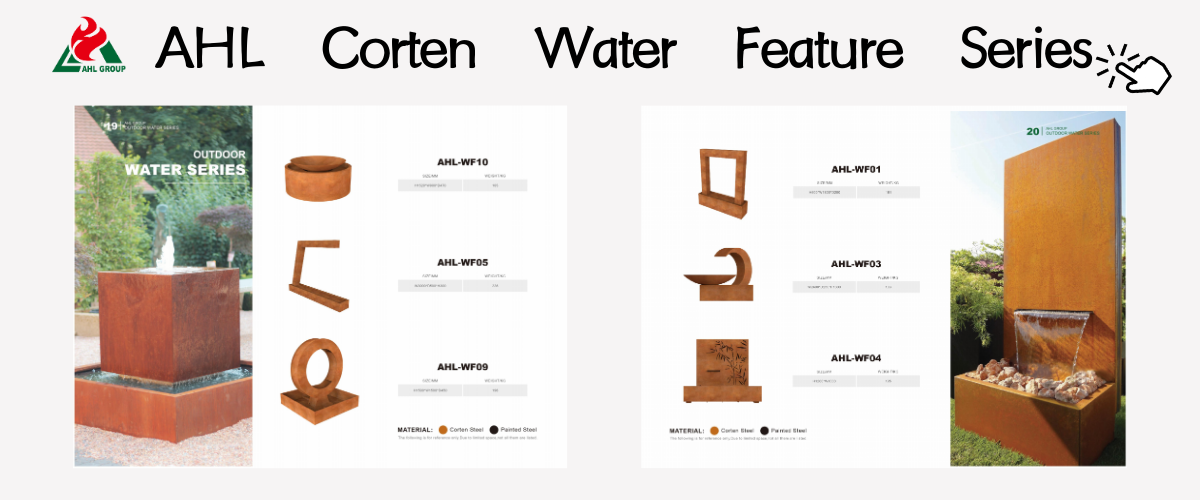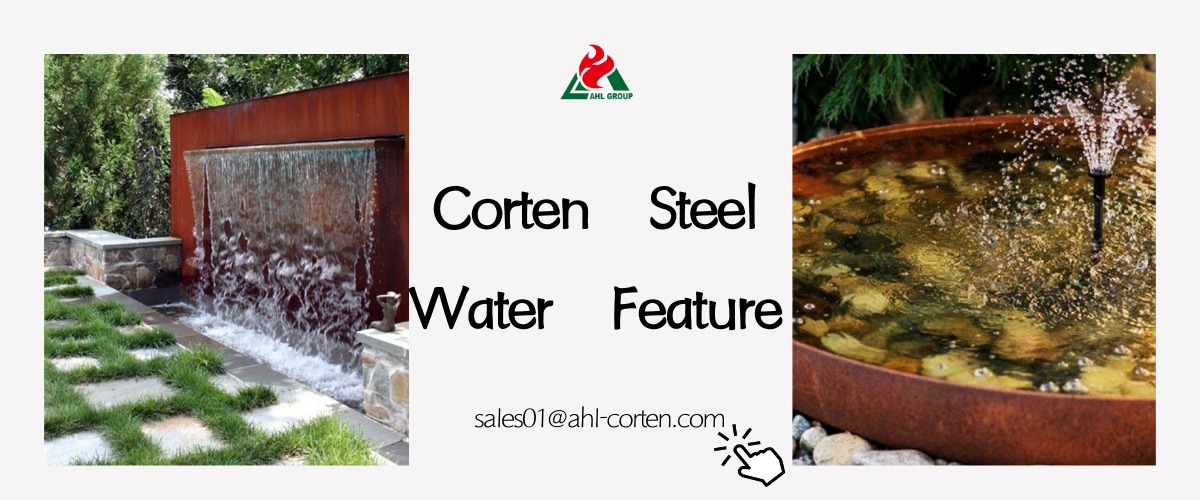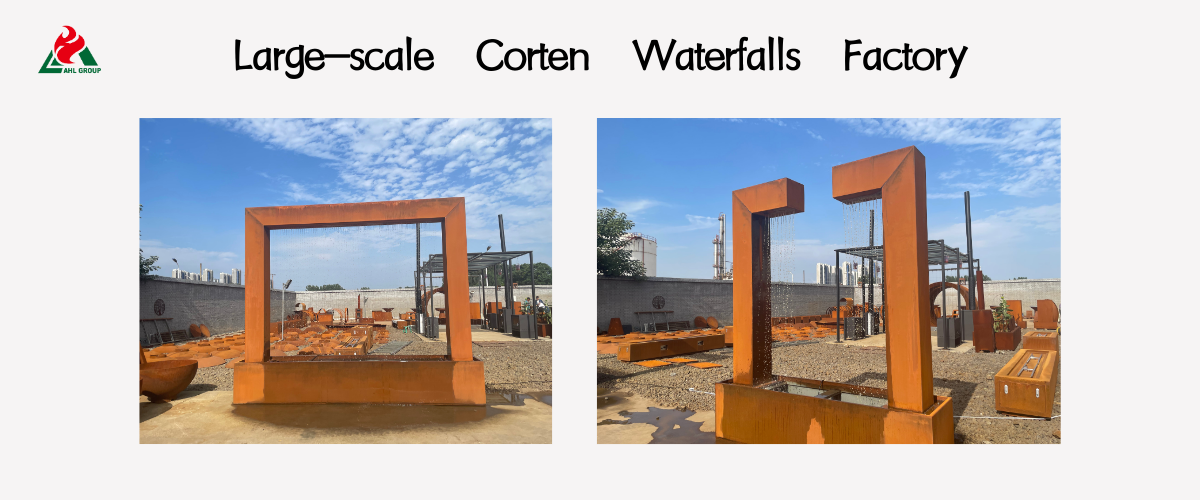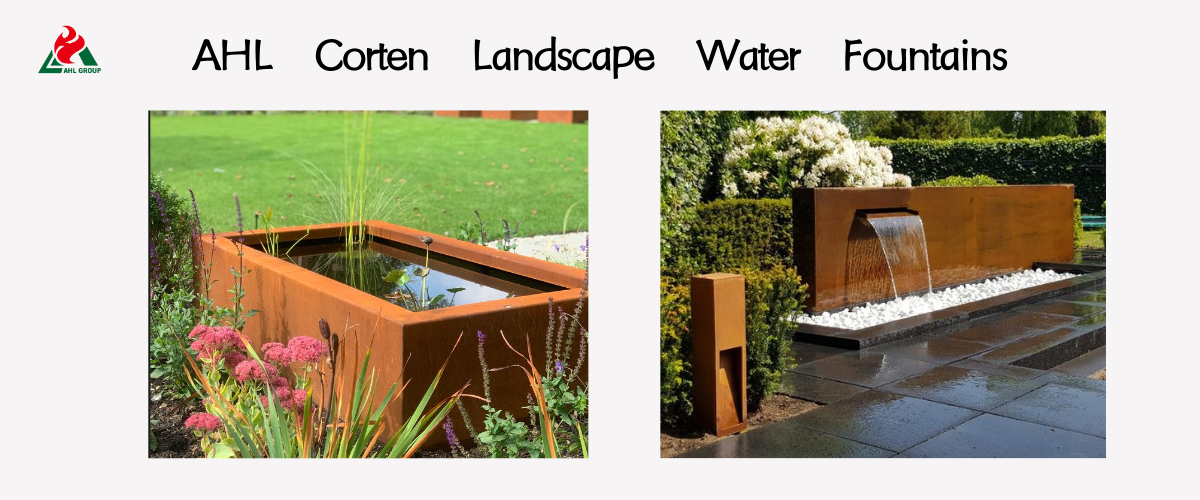Corten steel water features are recognized for their striking appearance and exceptional durability, making them a captivating focal point in any landscape. However, the performance and longevity of AHL Corten steel fountains or waterfalls depend entirely on the quality and proper specification of the system's core component—the pump. Selecting the optimal pump for Corten steel water features requires technical calculations, understanding maintenance requirements, and addressing the unique challenge of filtering naturally shed rust particles from the steel. This AHL Group guide unravels the mystery of pump selection, ensuring decades of trouble-free operation for your water feature.


Introduction to Water Feature Pump Systems
Water pumps are not merely motors but precision components engineered to overcome gravitational resistance and deliver specific water volumes.
Proper Selection is Critical
Underpowered pumps fail to achieve desired visual effects (e.g., producing weak bubbles or trickles instead of powerful cascades), while overpowered pumps waste energy and generate unnecessary noise. Proper sizing ensures optimized energy efficiency, reduced wear, and guarantees AHL Corten steel landscape water features precisely achieve their design intent—whether an elegant Corten steel fountain or a majestic Corten steel water curtain.
How Pump Performance Affects Water Feature Effects
Pump output parameters directly determine water feature effects:
► High Flow Rate (Gallons per Hour): Suitable for waterfalls, cascading waterfalls, and laminar flow features requiring substantial, continuous water flow.
► High Head: Ideal for vertical water projection features (e.g., tall water curtains or fountains where the pump is significantly below the water outlet).
► Low Flow/Low Head: Appropriate for simple aeration, bubble vases, or a small enclosed Corten steel water bowl.
Comprehensive Pump Comparison Guide
The optimal pump selection depends on landscape size, available power source, and maintenance access conditions.
Submersible Pumps: The Mainstream Choice
Submersible pumps are the most common and cost-effective option for garden landscapes. Designed to operate fully submerged, they utilize surrounding water to cool the motor.
Advantages for Most Weathering Steel Applications
Submersible pumps operate quietly, as the water effectively absorbs motor vibrations and noise. Installation is straightforward, requiring no additional piping systems beyond the discharge hose. This simplicity makes them the preferred choice for standard AHL weathering steel water bowls, small ponds, and circulation pools—scenarios where the pump housing can be easily concealed.
External Pumps: Suitable for Large or Complex Systems
External (or “in-line”) pumps are installed outside the pool or reservoir.
When to Choose External Installation Pumps
External pumps facilitate maintenance and typically have a longer service life than submersible pumps of the same size. They often offer higher efficiency when delivering large volumes of water against high resistance. AHL Group recommends external pumps for large-scale Corten metal water features or architectural systems requiring maximum flow and head capacity, where pump units must be concealed in basements or pump rooms.
Solar-Powered Pumps: Off-Grid Solutions
Solar pumps operate via photovoltaic panels, delivering fully autonomous low-pressure solutions.
Limitations and Optimal Applications
While installation flexibility (no wiring required) is a key advantage, solar pump output is constrained by sunlight intensity and battery capacity. They are best suited for small, aesthetically focused weathering steel bubble features or remote gardens prioritizing delicate water effects over peak performance. They are not recommended for high-drop waterfalls or high-flow fountains.

Technical Specifications Demystified
Selecting the right pump requires understanding three core parameters.
Understanding GPH, Head Height, and Power
► GPH (Gallons Per Hour): The pump's water delivery capacity. For waterfall features, typically 100 GPH is required per inch of weir width (outlet width).
► Head Height: The maximum vertical distance a pump can lift water. When calculating required head, include the vertical height of the landscape structure and friction losses from pipe fittings.
► Power: Represents the pump's energy consumption. Lower power consumption means AHL Corten water features reduce electricity costs over their operational lifespan.
Voltage Options: 12V, 24V, and 120V systems
► 12V/24V (Low Voltage): Standard for landscape lighting and medium-sized water features. Requires a transformer but offers enhanced safety and ease for DIY installation.
► 120V (Mains Voltage): Suitable for external pumps and ultra-high-power landscapes. Requires professional electrician installation.
Noise and Vibration Considerations
Landscapes near seating areas or windows require special attention to noise. Submersible pumps typically operate more quietly. When selecting external pumps, choose models with rubber anti-vibration feet and soundproof enclosures to minimize structural vibration transmission to the Corten steel base.
Special Considerations for Corten Water Features
When integrating pumps with weathering steel water fountains, specific strategies must be implemented to protect the equipment.
Preventing Pump Impeller Damage from Rust Particles
During the initial 6 to 12 months of weathering, weathering steel continuously releases trace amounts of loose iron oxide (rust) into the water. These fine particles are abrasive and may damage pump impellers or clog the inlet.
Pre-filtration and Maintenance Requirements
AHL Group strongly recommends installing a high-efficiency pre-filter (such as a large sponge block or filter bag) at the pump inlet, particularly during the first year of operation.
► Initial Phase: Clean the filter weekly for the first three months.
► Routine Maintenance: Clean the filter monthly to remove deposits and ensure optimal pump flow.
Water Treatment System Compatibility
If using algaecides or water clarifiers, ensure compatibility with pump materials (typically plastic and ceramic components) to prevent chemical corrosion. Rust water produced by weathering steel often naturally inhibits algae growth, frequently reducing chemical treatment requirements compared to standard configurations.

Top Pump Recommendations by Water Feature Type
Selecting the appropriate pump type based on the desired metal water feature effect is the most efficient way to achieve the ideal outcome.
Small Water Bowl and Bubble Water Features
Recommendation: Use a small, low-flow submersible pump (50-200 gallons per hour) with low head characteristics. Prioritize energy-efficient, easy-to-clean, quiet magnetic drive pumps.
Wall-Mounted and Cascading Water Fountains
Recommendation: Medium-to-high flow pumps (300-1200 gallons per hour) with sufficient head capacity. Precise head calculation is critical for achieving a uniform cascade width. High-performance submersible or external pumps are typically required for optimal results.
Large Ponds and Circulation Systems
Recommendation: Utilize high-flow submersible or external pumps rated for continuous operation. Prioritize energy efficiency metrics (low power consumption per unit flow rate) to minimize long-term operational costs for integrated AHL water feature systems.

Conclusion: Creating Captivating Outdoor Spaces with Corten Steel Water Features
The successful operation of AHL weathering steel water features hinges on a properly matched pump system. By prioritizing flow rate (gallons per hour) and head (lift height) calculations, integrating robust pre-filtration strategies to prevent initial rust runoff, and selecting modern LED systems that are energy-efficient and operate at low temperatures, you ensure both the enduring durability of the installation's mechanical core and the artistic integrity of the weathering steel exterior. Adhering to AHL's best practices for pump selection guarantees a flawless, low-maintenance landscape effect for years to come.


